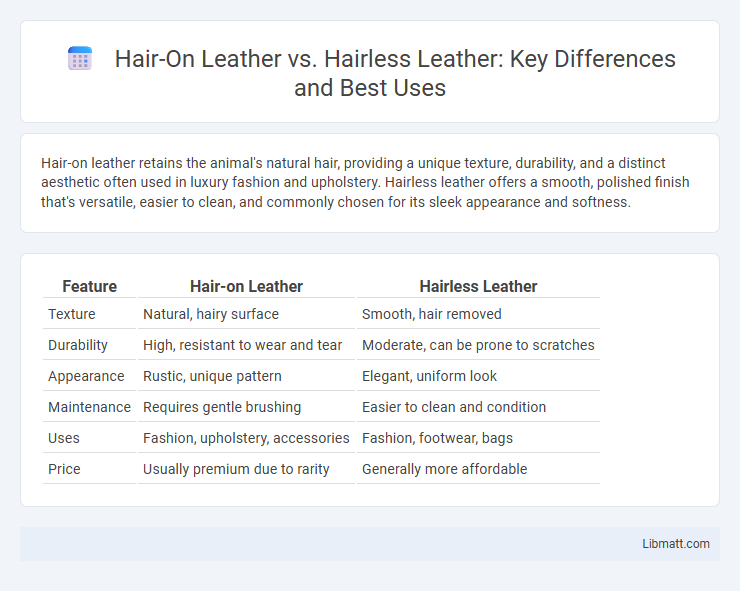Hair-on leather retains the animal's natural hair, providing a unique texture, durability, and a distinct aesthetic often used in luxury fashion and upholstery. Hairless leather offers a smooth, polished finish that's versatile, easier to clean, and commonly chosen for its sleek appearance and softness.
Table of Comparison
| Feature | Hair-on Leather | Hairless Leather |
|---|---|---|
| Texture | Natural, hairy surface | Smooth, hair removed |
| Durability | High, resistant to wear and tear | Moderate, can be prone to scratches |
| Appearance | Rustic, unique pattern | Elegant, uniform look |
| Maintenance | Requires gentle brushing | Easier to clean and condition |
| Uses | Fashion, upholstery, accessories | Fashion, footwear, bags |
| Price | Usually premium due to rarity | Generally more affordable |
Introduction to Hair-on Leather and Hairless Leather
Hair-on leather retains the animal's original hair or fur, offering a textured, natural look and added durability compared to hairless leather, which undergoes processing to remove hair, resulting in a smooth, uniform surface. Hair-on leather is prized for its unique aesthetic and insulation properties, while hairless leather is favored for its versatility in fashion and upholstery. Understanding the differences in appearance, maintenance, and application helps you choose the right leather for your specific needs.
Understanding the Differences: Hair-on vs Hairless Leather
Hair-on leather retains the animal's natural hair, offering a unique texture and increased durability while preserving the original hide's character and creating a bold aesthetic. Hairless leather, also known as smooth or full-grain leather, is tanned and finished to remove all hair, resulting in a sleek surface that highlights the leather's grain and is often softer and more flexible. Understanding these differences is crucial for selecting leather suited for specific applications, balancing factors such as appearance, maintenance, and longevity.
Types and Sources of Hair-on Leather
Hair-on leather comes primarily from cattle, deer, goats, and buffalo, preserving the animal's hair for a natural, rugged aesthetic, while hairless leather is typically derived from the same animals after complete hide processing and hair removal. Types of hair-on leather include cowhide with varying hair lengths and textures, calf hair leather known for its softness, and exotic variants such as zebra or pony hair sourced from specialized regions. Your choice depends on the texture and visual appeal you desire, as hair-on leather offers a distinct look with unique patterning compared to the smooth, uniform surface of hairless leather.
Characteristics of Hairless Leather
Hairless leather features a smooth, uniform surface achieved by removing the animal's hair and epidermis, resulting in enhanced durability and more consistent texture. It offers greater versatility for dyeing and finishing, allowing for a wide range of colors and finishes, making it ideal for luxury goods and upholstery. This type of leather is often more breathable and easier to maintain compared to hair-on leather, which retains the natural hair and presents a different aesthetic.
Aesthetic Appeal: Texture and Appearance Comparison
Hair-on leather features a natural, textured surface showcasing animal hair that adds depth and a rustic, unique aesthetic to furniture and accessories, while hairless leather offers a smooth, polished look prized for its elegance and versatility. The hair-on variety exhibits varied patterns and tactile richness, making each piece distinct, whereas hairless leather emphasizes a clean, uniform finish that highlights subtle grain details. Your choice between these two depends on whether you prioritize the organic, tactile charm of hair-on leather or the sleek sophistication of hairless leather for your design needs.
Durability and Longevity of Each Leather Type
Hair-on leather offers enhanced durability due to its natural hair fibers, which provide extra resistance to wear and tear, making it ideal for high-traffic use. Hairless leather, while often softer and more supple, may be more prone to scratches and requires more maintenance to maintain its longevity. Your choice depends on whether you prioritize rugged endurance or a smooth, refined appearance.
Common Uses and Applications
Hair-on leather is commonly used in fashion accessories, upholstery, and decorative items where texture and visual appeal are important, as it retains the animal's natural hair, providing a rugged and unique look. Hairless leather is favored in clothing, footwear, and handbags for its smooth finish, flexibility, and ease of customization, offering a sleek and polished appearance. Your choice depends on whether you prioritize durability and natural aesthetic or a refined, classic leather feel for everyday use.
Maintenance and Care Requirements
Hair-on leather requires gentle cleaning with a soft brush to preserve the hair fibers and avoid matting, while avoiding excessive moisture that can cause damage. Hairless leather demands regular conditioning and polishing to maintain its smooth texture and prevent cracks or dryness. Your choice should consider the specific maintenance needs, as hair-on leather is more delicate, whereas hairless leather involves routine care for durability.
Pricing and Market Value Analysis
Hair-on leather commands higher prices in niche markets due to its unique texture and aesthetic appeal, attracting luxury furniture and fashion brands seeking distinction. Hairless leather generally dominates mainstream markets with more consistent pricing, driven by its versatility and easier processing. Market value for hair-on leather remains stable within premium segments, while hairless leather benefits from broader commercial demand and supply chain efficiency.
Choosing the Right Leather: Pros and Cons
Hair-on leather offers a unique texture and natural appearance, providing durability and resistance to wear, but it requires careful maintenance to prevent matting and shedding. Hairless leather, known for its smooth finish and versatility, is generally easier to clean and more resistant to stains, making it ideal for high-traffic use. Your choice depends on whether you prioritize the rustic, tactile feel of hair-on leather or the sleek, low-maintenance nature of hairless leather.
Hair-on leather vs hairless leather Infographic

 libmatt.com
libmatt.com